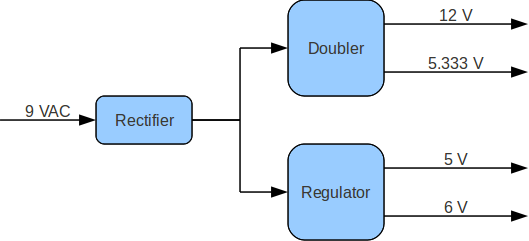This is an old revision of the document!
Table of Contents
The Power Supply
Schematic Overview:Power Supply
Inputs:
9 V AC, 50/60 Hz
Outputs:
5 V and 6 V, and the 12 V and 5.333 V
The power supply is relatively simple to understand. The power comes in at 9 V AC, 50/60 Hz, and goes to the rectifier. From here it is split into two sections, the 5 V and 6 V, and the 12 V and 5.333 V. At each section there are smoothing capacitors and bypass capacitors.
See the jumpers page for a list of which jumpers go where.
Block Diagram
The Rectifier and Smoother
The power input into the x0xb0x is 9 volt alternating current from an AC/AC adaptor. This needs to be converted to direct current before getting regulated to the different voltages. The 9 volt input is a root mean square value (rms) and is the value that is shown on a multimeter with the ac measuring setting. This means that the peak to peak voltage is 9 volts times the square root of two resulting in a peak to peak value of about 12.7 volt. Due to differences in ac adaptors the rms voltage could be over 10 volts resulting in a peak to peak voltage of about 14-15 volts.
The ac/dc conversion is done by the four 1N4001 diodes with what is called a bridge rectifier. You can see how a bridge rectifier works on the left hand side. While the bridge rectifier has in fact made sure our current is DC, it is in a state called "full wave varying DC". We don't have a smooth line of direct current, rather, we have a series of camel humps, where the voltage goes from zero, to the peak voltage back to zero.
The two 2.2 mF capacitors c3 and c5 perform a smoothing operation. When the voltage starts on its downward drop from the peak voltage to zero, the capacitors discharge, and the voltage drop is minimized. The DC waveform looks a lot smoother, and more like gentle waves rather than camel humps, and the varying voltage is quite minimal compared to the rectified output.
Regulated Voltage
The voltage regulators are very complex beasts. Essentially they take the gentle waves of the smoothed DC, and turn them in to a relatively perfect line of a specified output voltage. After the power is rectified and smoothed by C3 (a 2.2 mF capacitor) it is sent to the 7805 voltage regulator. The 0.1 mF capacitor before and after the regulator seem to be bypass capacitors to further smooth the waveform from any kind of interference and are part of the application suggestions in the 7805 datasheet. This then becomes the +5 V supply. This supply draws 33 mA average and 40 mA max depending on what kind of LED's you use.
The smoothed waveform is also sent to a 78L06Z, a low current voltage regulator. Again, with 0.1 mF capacitors before and after. This becomes the +6 V supply. The 6 V rail draws 14 mA average, irregardless of volume or whether or not notes are being played. One possibility of why this is, is that the LA4140 is an inefficient amplifier.
Doubled and Tuned Voltage
After the power is rectified and smoothed by C5 (the other 2.2 mF capacitor) it is sent through an RC network (100 Ohm and 100uF) before providing power to the Op Amp.
The power also goes through another RC network (1K Ohm and 100uf), before sent to the voltage reference circuit. This is taken from the LM336Z datasheet. TM6 allows to adjust the "breakdown voltage" of the voltage reference. D45-47 are used to "obtain a lower temperature coefficient". This is then sent to an op-amp set up to be a voltage follower, to eliminate any loading effects. (This makes sure that 5.333 V is available throughout the entire circuit?).
The 5.333 V is generated first with the voltage reference and buffer because it is the ac ground (virtual ground) for the whole circuit. It needs to be stable so is generated with this reference from ground rather than from a potentially unstable positive supply. It is buffered so it can supply current under load. The reason they chose 5.333 V is because it is evenly divisible by 0.08333 V (i.e. 1/12 volt or one note in a 1V/octave CV system).
The 5.333 V is sent to a non-inverting amplifier, with the 2.2 k and 1.8 k resistors. This provides a 2.222 V gain to the 5.333 V, equaling a voltage of 11.851 V, giving us the 12 V power supply. Capacitors C60 and C61 seem to be bypass capacitors.
This supply draws between 14 mA average and 16 mA max when playing notes. When silent, the draw is at 10 mA.



